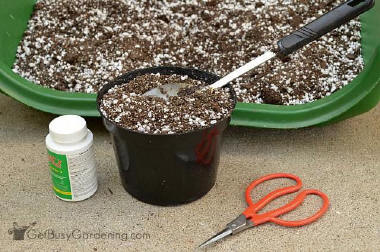
(6/26) Now that the hustle and bustle of spring and early summer gardening tasks are at an end, it’s time to think about other gardening projects. One rewarding chore that can generate new plants and keep your budget within reasonable bounds is propagating your own woody ornamental plants by making cuttings. This is an easy and inexpensive way to obtain more of your
favorite plants. August is a good time because the plants are still growing and healthy, and cuttings will be established before the colder fall weather arrives. Cuttings should be taken from current or past season’s growth. Always take cuttings from healthy, vigorous plants.
The tools and supplies you will need for successful cutting, gathering and propagating plants are simple--a clean, sharp knife or pruning shears, clean sterile plastic pots, and sterile growing medium. Pots should be washed and rinsed in a solution of 1 part bleach to 9 parts water. You should sterilize the cutting tools by dipping the blades in alcohol. You can use a
commercial rooting hormone which helps the cuttings get started, and for best results, you should start the cuttings in a sterile and well drained planting medium. I often use new seed starting potting soil, but you can make your own starting medium using coarse sand, a mixture of peat and perlite, or one part peat and one part sand.
If the weather is hot and dry, it is best to water the plants from which you will take cuttings late in the afternoon of the day before you gather cuttings. The best time to take cuttings is in the morning. Keep the cuttings cool and moist while gathering them. You can place some moist paper towels in the bottom of a paper bag or container to use as you collect
cuttings. And keep the container out of the sun. If you cannot start the cuttings right away, store them in a refrigerator.
 Cuttings should be 4 to 6 inches long. Remove the leaves from the lower half of the cutting. If you are collecting something with large leaves, you may reduce the size of the leaf by cutting it in half. I usually use a rooting hormone to start cuttings. Put some of the rooting hormone in a small container and
dip the base of the dry cutting into the powder hormone. Tap the dipped cutting stem to shake any excess powder off the stem. Throw out any unused rooting hormone left in the container.
Cuttings should be 4 to 6 inches long. Remove the leaves from the lower half of the cutting. If you are collecting something with large leaves, you may reduce the size of the leaf by cutting it in half. I usually use a rooting hormone to start cuttings. Put some of the rooting hormone in a small container and
dip the base of the dry cutting into the powder hormone. Tap the dipped cutting stem to shake any excess powder off the stem. Throw out any unused rooting hormone left in the container.
The rooting medium should be damp, but not overly wet. You can water it the day before inserting cuttings so it is not too wet. Use a wooden pencil to make a hole in the prepared rooting medium. Insert the cutting into the hole about half the length of the cutting, and using the pencil, tamp the rooting medium around the cutting. If you are starting several cuttings in
one container, leave enough space so that the leaves of each cutting will have sufficient light.
Water the rooting medium and cuttings lightly after all are planted. You may cover the cuttings with plastic to help retain moisture or plan to mist the cuttings frequently to keep the soil and the foliage moist. Place the cuttings in indirect light, avoiding direct sunlight. Cuttings usually do best in the 70 to 75 degree temperature range. Roots should appear in
about two weeks. At this point, a weak liquid fertilizer application is recommended. Once your cuttings are well rooted, at about 4 weeks, you should transplant them to a container so that they can grow to a suitable size for planting. Waiting just a little longer until they are a healthy size means more successful transplanting.
Following a few simple steps and carefully timing when you propagate your cuttings will result in many new plants for your landscape and to share with friends and neighbors.
Read other articles on gardening techniques